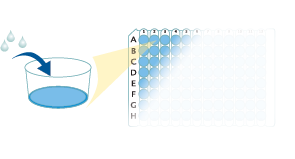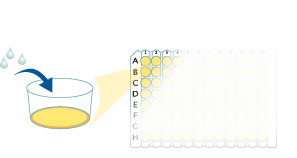Mouse IGFBP-3 Quantikine ELISA Kit Summary
Product Summary
Precision
Cell Culture Supernates, EDTA Plasma
| Intra-Assay Precision | Inter-Assay Precision | |||||
|---|---|---|---|---|---|---|
| Sample | 1 | 2 | 3 | 1 | 2 | 3 |
| n | 20 | 20 | 20 | 40 | 40 | 40 |
| Mean (pg/mL) | 280 | 628 | 2653 | 283 | 602 | 2648 |
| Standard Deviation | 13.5 | 25.1 | 148 | 23.4 | 44.4 | 156 |
| CV% | 4.8 | 4 | 5.6 | 8.3 | 7.4 | 5.9 |
Recovery
The recovery of mouse IGFBP-3 spiked to three levels throughout the range of the assay in the cell culture supernate samples was evaluated.
| Sample Type | Average % Recovery | Range % |
|---|---|---|
| Cell Culture Samples (n=4) | 100 | 90-109 |
Linearity
Scientific Data
Product Datasheets
Preparation and Storage
Background: IGFBP-3
The superfamily of insulin-like growth factor (IGF) binding proteins include the six high-affinity IGF binding proteins (IGFBP) and at least four additional low-affinity binding proteins referred to as IGFBP related proteins (IGFBP-rP). All IGFBP superfamily members are cysteine-rich proteins with conserved cysteine residues, which are clustered in the amino- and carboxy-terminal thirds of the molecule. IGFBPs modulate the biological activities of IGF proteins. Some IGFBPs may also have intrinsic bioactivity that is independent of their ability to bind IGF proteins. Post-translational modifications of IGFBP, including glycosylation, phosphorylation and proteolysis, have been shown to modify the affinities of the binding proteins to IGF. ALS (Acid Labile Subunit) is a liver-derived protein that exists in a ternary complex with Insulin-like Growth Factor (IGF)-binding Protein-3 (IGFBP-3) or IGFBP-5, and either IGF-I or IGF-II. ALS increases the half-life of IGF/IGFBP complexes in circulation.
Assay Procedure
Refer to the product- Prepare all reagents, standard dilutions, and samples as directed in the product insert.
- Remove excess microplate strips from the plate frame, return them to the foil pouch containing the desiccant pack, and reseal.
- Add 50 µL of Assay Diluent to each well.
- Add 50 µL of Standard, Control, or sample to each well. Cover with a plate sealer, and incubate at room temperature for 2 hours on a horizontal orbital microplate shaker.
- Aspirate each well and wash, repeating the process 4 times for a total of 5 washes.
- Add 100 µL of Conjugate to each well. Cover with a new plate sealer, and incubate at room temperature for 2 hours on the shaker.
- Aspirate and wash 5 times.
- Add 100 µL Substrate Solution to each well. Incubate at room temperature for 30 minutes on the benchtop. PROTECT FROM LIGHT.
- Add 100 µL of Stop Solution to each well. Read at 450 nm within 30 minutes. Set wavelength correction to 540 nm or 570 nm.





Citations for Mouse IGFBP-3 Quantikine ELISA Kit
R&D Systems personnel manually curate a database that contains references using R&D Systems products. The data collected includes not only links to publications in PubMed, but also provides information about sample types, species, and experimental conditions.
12
Citations: Showing 1 - 10
Filter your results:
Filter by:
-
The IGFBP3/TMEM219 pathway regulates beta cell homeostasis
Authors: F D'Addio, A Maestroni, E Assi, M Ben Nasr, G Amabile, V Usuelli, C Loretelli, F Bertuzzi, B Antonioli, F Cardarelli, B El Essawy, A Solini, IC Gerling, C Bianchi, G Becchi, S Mazzucchel, D Corradi, GP Fadini, D Foschi, JF Markmann, E Orsi, J Škrha, MG Camboni, R Abdi, AM James Shap, F Folli, J Ludvigsson, S Del Prato, G Zuccotti, P Fiorina
Nature Communications, 2022-02-03;13(1):684.
Species: Mouse
Sample Types: Serum
-
First use of gene therapy to treat growth hormone resistant dwarfism in a mouse model
Authors: KC Sia, SU Gan, SH Mohd Rodhi, ZY Fu, JJ Kopchick, MJ Waters, KO Lee
Gene Therapy, 2022-02-01;0(0):.
Species: Mouse
Sample Types: Serum
-
Thrombolysis by PLAT/tPA increases serum free IGF1 leading to a decrease of deleterious autophagy following brain ischemia
Authors: AM Thiebaut, I Buendia, V Ginet, E Lemarchand, MB Boudjadja, Y Hommet, L Lebouvier, C Lechevalli, M Maillasson, E Hedou, N Déglon, F Oury, M Rubio, J Montaner, J Puyal, D Vivien, BD Roussel
Autophagy, 2021-09-14;0(0):1-21.
Species: Mouse
Sample Types: Serum
-
Apolipoprotein�J is a hepatokine regulating muscle glucose metabolism and insulin sensitivity
Authors: JA Seo, MC Kang, WM Yang, WM Hwang, SS Kim, SH Hong, JI Heo, A Vijyakumar, L Pereira de, A Uner, H Huang, SH Lee, IS Lima, KS Park, MS Kim, Y Dagon, TE Willnow, V Aroda, TP Ciaraldi, RR Henry, YB Kim
Nat Commun, 2020-04-24;11(1):2024.
Species: Mouse
Sample Types: Plasma
-
Effects of Intestinal Microbiota on Brain Development in Humanized Gnotobiotic Mice
Authors: J Lu, L Lu, Y Yu, J Cluette-Br, CR Martin, EC Claud
Sci Rep, 2018-04-03;8(1):5443.
Species: Mouse
Sample Types: Serum
-
EGFR controls bone development by negatively regulating mTOR-signaling during osteoblast differentiation
Authors: M Linder, M Hecking, E Glitzner, K Zwerina, M Holcmann, L Bakiri, MG Ruocco, J Tuckermann, G Schett, EF Wagner, M Sibilia
Cell Death Differ., 2018-02-14;0(0):.
Species: Mouse
Sample Types: Cell Culture Supernates
-
Glucose intolerance in aging male IGFBP-3 transgenic mice: differential effects of human IGFBP-3 and its mutant IGFBP-3 devoid of IGF binding ability.
Authors: Nguyen K, Yao X, Erickson A, Mishra S, Nyomba B
Endocrinology, 2014-12-09;156(2):462-74.
Species: Mouse
Sample Types: Serum
-
PAI-1-regulated extracellular proteolysis governs senescence and survival in Klotho mice.
Authors: Eren M, Boe A, Murphy S, Place A, Nagpal V, Morales-Nebreda L, Urich D, Quaggin S, Budinger G, Mutlu G, Miyata T, Vaughan D
Proc Natl Acad Sci U S A, 2014-04-28;111(19):7090-5.
Species: Mouse
Sample Types: Plasma
-
Fish oil slows prostate cancer xenograft growth relative to other dietary fats and is associated with decreased mitochondrial and insulin pathway gene expression.
Authors: Lloyd J, Masko E, Wu C, Keenan M, Pilla D, Aronson W, Chi J, Freedland S
Prostate Cancer Prostatic Dis, 2013-07-23;16(4):285-91.
Species: Mouse
Sample Types: Serum
-
Deletion of beta-adrenergic receptor 1, 2, or both leads to different bone phenotypes and response to mechanical stimulation.
Authors: Pierroz DD, Bonnet N, Bianchi EN, Bouxsein ML, Baldock PA, Rizzoli R, Ferrari SL
J. Bone Miner. Res., 2012-06-01;27(6):1252-62.
Species: Mouse
Sample Types: Serum
-
Caloric restriction reduces growth of mammary tumors and metastases.
Authors: De Lorenzo M, Baljinnyam E, Vatner D, Abarzua P, Vatner S, Rabson A
Carcinogenesis, 2011-06-10;32(9):1381-7.
Species: Mouse
Sample Types: Serum
-
Sexual dimorphism in cortical bone size and strength but not density is determined by independent and time-specific actions of sex steroids and IGF-1: evidence from pubertal mouse models.
Authors: Callewaert F, Venken K, Kopchick JJ, Torcasio A, van Lenthe GH, Boonen S, Vanderschueren D
J. Bone Miner. Res., 2010-03-01;25(3):617-26.
Species: Mouse
Sample Types: Serum
FAQs
No product specific FAQs exist for this product, however you may
View all ELISA FAQsReviews for Mouse IGFBP-3 Quantikine ELISA Kit
There are currently no reviews for this product. Be the first to review Mouse IGFBP-3 Quantikine ELISA Kit and earn rewards!
Have you used Mouse IGFBP-3 Quantikine ELISA Kit?
Submit a review and receive an Amazon gift card.
$25/€18/£15/$25CAN/¥75 Yuan/¥2500 Yen for a review with an image
$10/€7/£6/$10 CAD/¥70 Yuan/¥1110 Yen for a review without an image





